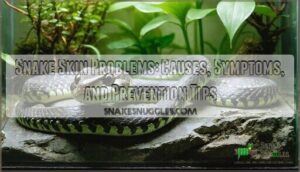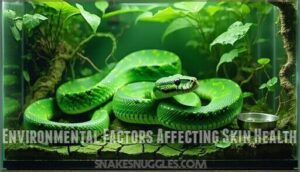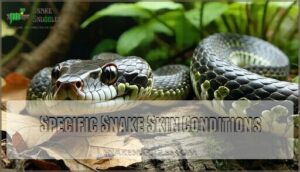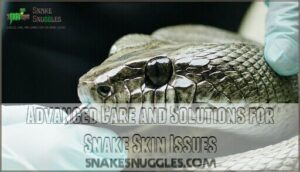This site is supported by our readers. We may earn a commission, at no cost to you, if you purchase through links.
 Snake skin problems can come from poor humidity, dirty habitats, or even pesky parasites.
Snake skin problems can come from poor humidity, dirty habitats, or even pesky parasites.
Look out for trouble signs like incomplete shedding, discolored scales, or swelling.
Stuck shed? That might mean your scaly friend’s environment is too dry.
Red, irritated skin? It could be a bacterial issue—or just bad news from a wet substrate.
Dirty enclosures and improper diets are also common culprits.
Regular inspections, proper heating, and balanced nutrition keep these issues at bay.
Think of it like giving your snake a superior spa day!
Stay sharp—catching problems early makes all the difference in keeping your snake happy and healthy.
Table Of Contents
- Key Takeaways
- Recognizing Snake Skin Problems
- Causes of Snake Skin Problems
- Creating a Healthy Habitat for Snakes
- Preventing Snake Skin Problems
- Specific Snake Skin Conditions
- Shedding and Skin Renewal in Snakes
- Heat Injuries and Scale Rot in Snakes
- Bacterial and Viral Infections in Snakes
- Advanced Care and Solutions for Snake Skin Issues
- Veterinary Care and Maintenance for Healthy Skin
- Frequently Asked Questions (FAQs)
- What does snake skin rot look like?
- How do you treat a snake skin infection?
- What are the symptoms of snake skin disease?
- Do snake skins carry diseases?
- How do I safely bathe my snake?
- What substrates should I avoid for snakes?
- How often should snakes be misted?
- Can snakes get sunburned in captivity?
- What signs indicate snake dehydration?
- Can stress affect snake skin health?
- Conclusion
Key Takeaways
- Keep your snake’s enclosure clean and maintain proper humidity levels to prevent infections and shedding issues.
- Watch for early signs like redness, blisters, abnormal shedding, or changes in behavior to catch problems before they worsen.
- Provide a balanced diet and avoid substrates like cedar or pine shavings that can harm your snake’s skin.
- Regularly inspect your snake’s skin for parasites, discoloration, and injuries, and handle shedding problems with proper hydration support.
Recognizing Snake Skin Problems
You can spot snake skin problems by keeping an eye out for unusual shedding, discoloration, or blisters.
Spot snake skin problems early by checking for irregular shedding, discoloration, or blisters—your pet’s health depends on it!
Catching these signs early helps prevent minor issues from turning into serious health concerns.
Common Skin Issues in Snakes
In the context of snake skin problems, early detection is key to keeping your scaly friend healthy.
Skin parasites, fungal infections, and other issues can sneak up on you if you’re not paying attention. Regular checks make all the difference.
Here’s what to watch for:
- Skin parasites: Look for mites or ticks, which often cause itching and lethargy.
- Blister disease: Dirty or overly moist habitats can lead to fluid-filled lesions.
- Snake shedding issues: Dry environments may cause retained skin, a condition called dysecdysis.
A clean, well-maintained habitat is your first line of defense against snake skin infections.
Symptoms of Skin Infections
Snake skin infections often leave telltale signs that demand your attention. Redness or swelling could point to bacterial infections, while lesions and blisters signal possible habitat issues or scale rot. Abnormal shedding, like retained skin, often ties back to environmental problems.
Watch for redness, blisters, or abnormal shedding—early signs of skin infections that demand immediate attention to protect your snake’s health.
Keep an eye on behavioral changes, such as lethargy or appetite loss, as these can accompany skin lesions or infections.
Here’s a quick guide:
| Symptom | Potential Cause | What to Do |
|---|---|---|
| Redness/Swelling | Bacterial infections | Consult a reptile vet |
| Lesions/Blisters | Dirty environment | Improve habitat hygiene |
| Abnormal Shedding | Low humidity | Adjust enclosure conditions |
| Appetite Loss | Systemic infection | Seek immediate medical care |
Act fast—your snake’s health depends on it!
Early Detection of Skin Problems
Spotting snake skin problems early keeps things manageable. Regular visual inspection helps you catch early warning signs before they escalate.
Watch for:
- Skin abnormalities like bumps, blisters, or discoloration.
- Changes in shedding patterns, such as stuck skin or incomplete sheds.
- Behavioral changes, including lethargy or rubbing against surfaces.
Combine these checks with proper quarantine protocols for new snakes. Catching snake skin lesions early guarantees faster treatment and prevents serious snake skin conditions from taking hold.
Causes of Snake Skin Problems
Snake skin problems often arise from environmental issues, poor hygiene, or inadequate nutrition.
By understanding these common causes, you can take steps to keep your snake healthy and its skin in top condition.
Environmental Factors Affecting Skin Health
Think of your snake’s enclosure as their private spa.
Off-kilter humidity levels, poor ventilation quality, or improper temperature gradients can quickly trigger snake skin problems like shedding issues or infections.
Factors like substrate choice and enclosure size also impact reptile skin hydration.
A well-maintained balance in these snake environmental conditions keeps your pet comfortable and their skin healthy.
Poor Habitat Hygiene and Its Effects
Neglecting hygiene in your snake’s habitat can invite trouble, like skin infections or mite infestations. Keep your snake immune to issues by maintaining clean surroundings.
Follow these steps:
- Control waste buildup—clean feces and uneaten prey often.
- Substrate care—replace dirty bedding to prevent contamination.
- Enclosure disinfection—regularly sanitize surfaces to stop bacteria and fungi.
Great hygiene equals healthier snakes!
Nutritional Deficiencies and Skin Issues
Skin problems aren’t just about the habitat—nutrition matters too.
Reptile skin disease often stems from an improper diet or vitamin deficiencies.
Boost your snake’s health with these steps:
- Avoid vitamin deficiencies: Focus on Vitamin A for shedding and skin strength.
- Prevent mineral imbalances: Certify adequate calcium for healthy scales.
- Watch supplementation risks: Over-supplementing can harm more than help.
Feed thoughtfully, avoid obesity affects.
Creating a Healthy Habitat for Snakes
If you want your snake to stay healthy, creating the right habitat is key.
By maintaining proper temperatures, humidity, and clean substrate, you can prevent many common skin problems and keep your pet comfortable.
You can ensure your pet’s well-being by following these guidelines.
Proper Temperature and Humidity Levels
Getting temperature gradients and humidity monitoring right isn’t guesswork—it’s the key to solving reptile skin problems.
Different species have unique environmental control needs, so research yours.
Proper temperature keeps your snake active, while balanced humidity aids shedding success.
Avoid extremes, as they can lead to issues like snake shedding troubles or bacterial infections.
Use thermometers and hygrometers for precision!
Suitable Substrates for Snakes
Choosing the right substrate is essential for your snake’s health and preventing skin problems.
It impacts Substrate Hygiene, Humidity Retention, and Burrowing Behavior.
Here are four excellent options:
- Aspen Shavings: Cost-effective with good drainage for a clean snake environment.
- Cypress Mulch: Superb for naturalistic bioactivity and boosting humidity retention.
- Paper Towels: A budget-friendly, hygienic choice that simplifies snake environment management.
- Coconut Fiber: Great for burrowing behavior and holding moisture.
Consider where to find quality reptile bedding for your snake.
Avoid substrates prone to bacteria or causing impaction.
Replace regularly for ideal snake health.
Heating and Lighting Considerations
Creating a proper snake habitat means balancing heating and lighting considerations.
UVB lighting guarantees proper vitamin D production, while basking spots help your snake regulate its temperature.
Maintain a temperature gradient in the enclosure for movement between warm and cool areas.
At night, slightly lower temperatures mimic natural conditions—just keep nighttime heat consistent to avoid stress.
Always prioritize UVB lighting safety and bulb placement to prevent burns.
Consider snake UVB options for superior reptile health.
Good temperature and humidity control prevent snake skin problems and promote health.
Proper management of these factors is crucial for the health of your snake.
Preventing Snake Skin Problems
Keeping your snake’s skin healthy starts with simple habits like regular inspections and maintaining a clean habitat.
When you combine these with proper feeding practices and balanced nutrition, you’ll reduce the risk of skin problems substantially, which is crucial for maintaining your snake’s overall health and well-being.
Regular Skin Inspections and Checks
Think of skin inspections like a wellness check for your snake.
Regular checkups catch shedding issues, mites, or infections early.
When handling your snake:
- Inspect for discoloration—it signals snake skin problems.
- Feel for abnormal bumps, warning of hidden health risks.
- Check for blisters or sores caused by poor conditions.
- Spot mites or ticks, a threat to reptile health.
Providing a Balanced Diet for Snakes
A balanced diet is your snake’s secret weapon against skin problems.
Focus on prey variety, proper supplementation needs, and preventing obesity while maintaining hydration importance.
Here’s a quick breakdown:
| Diet Factor | Benefit | Tip |
|---|---|---|
| Prey Variety | Promotes reptile nutrition | Rotate prey like mice and rats. |
| Supplementation Needs | Boosts overall health | Add calcium for strong skin. |
| Feeding Schedule | Prevents obesity | Stick to an age-appropriate plan. |
Healthy snake, healthy skin!
Safe Prey Options and Feeding Frequency
It’s no secret—choosing the right prey improves snake health and prevents potential issues like snake skin problems.
Here’s how to nail it:
- Prey size should match your snake’s widest body part to ease digestion.
- Stick to a consistent feeding schedule based on species and age.
Prioritize nutritional variety with options like frozen vs. live prey, but avoid live feed without supervision to prevent prey bites harming your snake’s skin.
Specific Snake Skin Conditions
In regards to snake skin conditions, understanding the specific issues your snake might face is essential for their health.
From bacterial infections like mouth rot to pesky mites, each condition has unique signs you shouldn’t ignore, which is crucial for maintaining your snake’s overall well-being and addressing potential health issues promptly.
Infectious Stomatitis (Mouth Rot)
Mouth rot, or infectious stomatitis, can really mess with your snake’s health—and your wallet.
Bleeding gums, thick mucus, and a sour smell? Those are big red flags. This bacterial infection thrives in poor conditions but can spread fast if ignored.
| Symptom | Cause | Treatment |
|---|---|---|
| Bleeding gums | Bacterial overgrowth | Antibiotics |
| Thick mucus, discharge | Poor hygiene | Oral rinses |
| Foul head odor | Compromised immunity | Professional cleaning |
Preventing stomatitis means keeping your snake’s diet balanced and habitat clean.
Treat advanced stomatitis ASAP to avoid lasting damage.
Internal and External Parasites
Parasites can wreak havoc on your snake’s skin and health.
Spotting issues early is key:
- Helminth Infections: Look for weight loss or regurgitation.
- Mite Infestations & Tick Removal: Check for itching, black spots, or red dots on scales.
- Protozoal Parasites & Coccidia Treatment: Detect diarrhea early.
- Prevention: Clean your snake’s habitat often to avoid infestations.
Skin Infections (Dermatitis)
Ever noticed red, inflamed patches on your snake’s scales? That’s likely bacterial dermatitis or a snake fungal infection like Ophidiomyces ophiodiicola.
Skin infections, including blister disease, often stem from dirty enclosures or poor conditions.
Treat bacterial infections with antibiotics and fungal infections with antifungals. Make certain the habitat is clean and dry to prevent scale rot or abscesses.
Early abscess treatment and habitat upkeep are essential to control any snake skin infection effectively.
Respiratory Disease and Infections
Respiratory infections in snakes, such as viral pneumonia or fungal infections, can creep in unnoticed.
Look for signs like wheezing, nasal discharge, or open-mouth breathing.
Proper care—clean habitats, correct humidity, and controlled temperatures—keeps respiratory disease at bay.
If your snake shows symptoms, consult a vet for treatments like nebulization therapy or antibiotics.
Early action prevents risks like antibiotic resistance.
Poor ventilation is a major environmental stressor that increases infection risk.
Shedding and Skin Renewal in Snakes
Shedding is a normal and essential part of a snake’s life, allowing it to grow and refresh its skin.
Understanding the process and recognizing problems early can help you guarantee your snake stays healthy and comfortable.
Normal Shedding Process in Snakes
Shedding, or ecdysis, keeps your snake healthy by renewing its skin layers.
It’s fascinating to observe this natural process.
Watch for these key shedding cycle milestones:
- Ecdysis Frequency: Matches their growth and health.
- Behavioral Changes: Dull skin, hiding, or decreased appetite signal shedding.
- Lubrication Process: Helps slough off old skin smoothly.
Good snake skin care guarantees successful, healthy snake shedding.
Snakes require humidity for sloughing to occur properly.
Shedding Problems and Causes
Shedding issues, like incomplete sheds or an abnormal molt, often stem from low humidity levels, old injuries, or stress.
Poor diet plays a role too, as nutritional impact affects skin health.
Mite infestations can disrupt a smooth snake shedding cycle, while general neglect of environmental needs encourages snake dysecdysis causes.
Keeping conditions stable prevents shedding problems and eases your snake’s natural process.
Assisting Your Snake With Shedding
When facing snake shedding problems, create ideal humidity levels to keep their skin hydrated.
Handle shedding issues with these steps:
- Address incomplete snake sheds with 20-minute soaks in lukewarm water.
- Use shedding aids like moist towels if skin sticks.
- Check for stuck eye caps during the snake shedding cycle.
- Provide dietary support for smoother skin regeneration to ensure a healthy shed.
The key to successful shedding is maintaining the right environment and providing the necessary care, including dietary support.
Heat Injuries and Scale Rot in Snakes
In the context of snake care, heat injuries and scale rot can sneak up on you if you’re not paying attention to their habitat.
By maintaining proper temperatures and keeping the enclosure clean, you can prevent these common but serious skin problems, specifically heat injuries.
Causes of Heat Injuries in Snakes
Heat injuries in snakes often stem from heating pad malfunctions, hot rock dangers, improper thermostats, or poorly designed enclosures.
Without proper monitoring, temperature fluctuations and basking too long can cause painful thermal burns. Make certain your snake’s habitat has safe heat sources and balanced airflow.
| Cause | Effect |
|---|---|
| Heating pad malfunctions | Skin burns, stress |
| Hot rock dangers | Severe blisters |
| Improper thermostats | Overheating, lethargy |
| Basking spot burns | Painful thermal burns |
A careful setup keeps your snake safe and its skin healthy.
Symptoms of Scale Rot
Scale rot often starts with scale discoloration, softened scales, or blister-like lesions on affected areas, signaling a snake skin infection.
Watch for brownish, crusty patches or oozing spots, as these can progress to snake blisters or bacterial infections.
Left unchecked, secondary infections can develop, and early detection includes looking for discolored patches on scales.
Catching these snake skin problems early helps guarantee effective scale rot treatment and prevents lasting harm.
Treatment and Prevention of Heat Injuries
Preventing heat injuries isn’t rocket science—just thoughtful care.
Try these steps:
- Calibrate thermostats and provide cooling zones, letting your snake escape excessive heat.
- Choose non-conductive substrates to prevent overheating and blister management woes.
- Regularly inspect for burns or blisters, using burn creams for minor issues and consulting vets for serious ones.
Smart habitat control keeps snake skin problems at bay!
Bacterial and Viral Infections in Snakes
Bacterial and viral infections in snakes can cause serious skin problems, often affecting their overall health if left untreated.
By recognizing symptoms like redness, swelling, or unusual behavior early, you can help prevent these infections from turning into major issues, which is crucial for maintaining the snake’s health.
Common Bacterial Infections in Snakes
Bacterial infections, like bacterial dermatitis and septicemia, can spell trouble for snakes.
Watch for septicemia symptoms—lethargy or red belly scales—and take quick action. Poor husbandry impacts snake health, often triggering abscesses or infections.
Effective abscess treatment and antibiotic therapy, guided by a vet, are essential. Regular check-ups can also help detect internal and skin parasites early on.
Maintain clean habitats to prevent snake skin problems and keep your slithery friend thriving, ensuring overall snake health.
Viral Infections and Their Transmission
Regarding snake viral diseases, understanding transmission is critical. Inclusion body disease (IBD), a significant threat in snakes like boas and pythons, spreads via direct contact, respiratory secretions, or even through contaminated surfaces.
Sneaky viruses like Paramyxovirus and Nidovirus impact the respiratory system, causing severe health challenges.
To shield your snakes, follow these quarantine protocols:
- Quarantine new snakes for at least three months.
- Keep a clean habitat to reduce viral shedding risks.
- Monitor for symptoms, like neurological issues and lethargy.
- Avoid cohabiting incompatible species, especially boas and pythons.
Early detection, isolation, and regular checks help stop snake disease transmission in its tracks.
Treatment Options for Bacterial Infections
Tackling bacterial infections requires a mix of strategies. Start with antibiotic therapy for targeted treatment. Use topical treatments for surface infections, paired with gentle wound cleaning.
Severe infections may need surgical drainage or laser therapy. Don’t forget probiotics use to restore gut health!
Diagnostic testing is essential for proper diagnosis.
| Treatment Type | Purpose | When to Use | Example Tool |
|---|---|---|---|
| Antibiotic Therapy | Kill bacteria | Severe infections | Enrofloxacin |
| Topical Treatments | Treat surface issues | Minor skin problems | Povidone-iodine |
| Surgical Drainage | Remove abscesses | Abscess or deeper wounds | Scalpel and suction |
| Supportive Care | Speed recovery | During and post-treatment | Increased hydration |
Advanced Care and Solutions for Snake Skin Issues
When your snake’s skin problems go beyond the basics, advanced care can make a big difference.
From cutting-edge treatments to surgical options, these solutions address even the most stubborn issues effectively.
Advanced Treatment Options for Skin Issues
When your snake’s skin needs advanced care, these cutting-edge treatments can help:
- Laser Treatment: Heals damaged areas with pinpoint precision.
- Topical Treatments: Antibiotics and antifungal medications tackle infection.
- Wound Debridement: Removes dead tissue to speed up recovery.
- Experimental Therapies: Stem cells, ozone therapy, or skin grafting explore new horizons.
These options restore your snake’s health while ensuring vibrant scales!
Surgical Interventions for Skin Problems
For severe snake skin issues, surgical intervention may be necessary.
Procedures like lesion removal, abscess drainage, or skin grafting can restore health.
Wound debridement clears infection, while grafting techniques repair damaged areas.
Skin biopsies guide treatment, facilitating precise care.
Post-op care, including clean habitats and gentle handling, supports recovery.
Reptile dermatology expertise guarantees your snake sheds its troubles gracefully, with precise care.
Experimental Treatments for Snake Skin Conditions
High-tech solutions are rewriting the rules of reptile dermatology. If your snake’s skin problems seem stubborn, cutting-edge experimental treatments might help.
Techniques like Phage Therapy target harmful bacteria without harming good microbes, while Stem Cells repair damaged skin and promote regeneration. Gene Therapy shows promise for tackling genetic snake skin disorders by addressing the problem at its root.
Meanwhile, Immunomodulation, supported by probiotics, strengthens your scaly friend’s natural defenses.
These innovations don’t replace proper care but can work alongside antifungal medications and antibiotic therapy for tricky skin infections.
- Promote healing with Stem Cells.
- Use Probiotics to enhance defenses.
- Fight bacteria using Phage Therapy.
- Explore Gene Therapy for lasting results.
Veterinary Care and Maintenance for Healthy Skin
You play a key role in keeping your snake’s skin healthy by scheduling regular vet checkups and maintaining a clean habitat.
A little extra care, like isolating sick snakes for recovery, prevents small issues from turning into big problems, and this is crucial for maintaining your snake’s overall health.
Regular Veterinary Checkups and Assessments
In regards to reptile health, regular vet visits are your snake’s secret weapon.
Early detection of problems like skin infections or respiratory issues can make all the difference in avoiding bigger headaches later. Think of these checkups as your snake’s yearly tune-up—your vet uses diagnostic tools to spot issues you might miss, from parasites to snake skin problems like scale rot.
A good vet doesn’t just treat issues; they help craft a treatment plan for long-term health. Whether it’s advice on humidity tweaks or nutrition, these tips guarantee your snake thrives.
Remember, preventative care is always easier (and cheaper) than emergency fixes. Keep your scaly friend happy with consistent and proactive snake veterinary care!
Isolating The Snake for Recovery
Recovery time means setting up a proper quarantine setup where your snake gets their own space to heal.
This facilitates a better environment and prevents spreading illnesses.
Focus on:
- Stress reduction by keeping the area calm and quiet.
- Hygiene protocols like clean substrate and fresh water.
- Monitoring symptoms daily for progress.
- Providing post-isolation care before reintroducing them.
This setup guarantees better snake disease management and recovery.
Habitat Cleaning and Disinfection
Cleanliness in your snake’s enclosure is non-negotiable. Use reptile-safe disinfectants to maintain hygiene, prevent diseases, and support healthy skin.
Stick to a cleaning schedule and sanitize water bowls regularly. Focus on removing waste and dirt, and choose substrates that resist mold. For stubborn buildup, snake deep cleaning is necessary.
Proper snake habitat hygiene is key to prevention. Consistent habits like these safeguard your pet’s wellbeing.
| Task | Frequency | Tips |
|---|---|---|
| Waste removal | Daily | Use gloves for easier handling. |
| Deep cleaning | Weekly | Include disinfectant scrubbing. |
| Water sanitation | Every 2-3 days |
Replace bowls to avoid buildup.
Frequently Asked Questions (FAQs)
What does snake skin rot look like?
Snake skin rot looks like red, inflamed skin with soft, discolored scales that may blister or ooze.
You might notice a sour smell, peeling areas, or lesions, often caused by poor hygiene or excessive moisture.
How do you treat a snake skin infection?
To treat a snake skin infection, focus on improving habitat conditions—maintain proper humidity, cleanliness, and temperature.
Pair this with veterinary-prescribed antibiotics or antifungal treatments.
Always isolate the snake to prevent spreading the infection, and ensure to follow the treatment plan carefully for the best recovery.
What are the symptoms of snake skin disease?
Think of skin disease as your snake’s SOS.
Watch for redness, swelling, blister-like lesions, unusual shedding, wrinkly skin, foul odors, or lethargy.
Dehydration signs, like dry scales or sunken eyes, might tag along too.
Do snake skins carry diseases?
Yes, snake skins can carry diseases like salmonella, which poses risks to humans.
Always handle snake skins carefully, wash your hands afterward, and disinfect surfaces to avoid spreading harmful bacteria or pathogens.
How do I safely bathe my snake?
Gently place your snake in lukewarm water, just over 100°F, ensuring it’s shallow enough to avoid stress.
Let it soak for 10-15 minutes, then pat it dry completely before returning it to its clean habitat.
What substrates should I avoid for snakes?
A snake’s home is its sanctuary, so avoid cedar or pine shavings.
Their oils can harm your snake’s skin and lungs.
Sand, scented substrates, and wired bottoms can also cause irritation or injuries.
How often should snakes be misted?
Mist snakes sparingly—usually every few days or when the humidity drops below their needs.
Over-misting leads to health issues, so check the humidity with a hygrometer and adjust accordingly to keep them comfortable.
Can snakes get sunburned in captivity?
Too much direct sunlight or overly bright artificial light can cause a snake’s skin to burn, leading to redness and irritation.
Always provide shady spots in their enclosure to protect them from unnecessary UV exposure, particularly to prevent irritation.
What signs indicate snake dehydration?
When your snake’s skin resembles crinkled paper, their eyes appear sunken, and they move sluggishly, it’s a red flag for dehydration.
Provide fresh water, adjust humidity, and consider a vet visit if needed.
Can stress affect snake skin health?
Stress can absolutely mess with a snake’s skin health.
It weakens their immune system, making them prone to infections and shedding issues.
Keep their environment calm and conditions ideal to avoid unnecessary stress-induced problems.
Conclusion
Much like armor needs upkeep, your snake’s skin requires care to stay healthy.
Snake skin problems can stem from issues like poor humidity, dirty enclosures, or nutritional gaps.
Regular checks, proper habitat conditions, and a balanced diet are your best defense against trouble.
Keep an eye out for signs like shedding problems or discolored scales, and act fast to address them to ensure your scaly companion stays happy and healthy for years to come.
- https://www.vettimes.co.uk/app/uploads/wp-post-to-pdf-enhanced-cache/1/snakes-husbandry-and-common-health-problems.pdf
- https://vcahospitals.com/know-your-pet/snakes-problems
- https://wpvet.com/exotic-pets-care-guides/reptile-shedding-ecdysis
- https://www.vin.com/apputil/content/defaultadv1.aspx?pId=24437&catId=137408&id=9382768&ind=95&objTypeID=17
- https://www.dvm360.com/view/bacterial-diseases-reptiles-proceedings




















